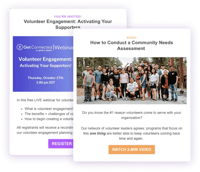Free volunteer program planning worksheet
Achieving community impact with a limited budget and resources is no easy task for a volunteer program.
However, with a little strategic planning and creativity, it's possible to maximize impact, even if you're challenged with a smaller budget.
In this guide for small organizations, we’ll explore time-tested strategies for leveraging partnerships, creativity, and technology so you can make real change and lasting impact in your community … even on a shoe-string budget!
1. Clearly Define Your Mission and Focus Area
Small volunteer programs need to focus their limited resources effectively and efficiently. Drafting a strong mission statement will guide the way you allocate precious funds and staff time. This clearly defined focus and mission will help you stay on track and prevent mission creep, which could inadvertently drain valuable resources.
A focused mission statement leads to focused programming, which makes it easier to successfully promote volunteer and partnership opportunities. This will also help you in securing donations, because your support base will see you as the go-to organization for your specific mission or services.
>> Stay in tune with your community needs through a community needs assessment and keep your programming focused + and on mission.
2. Leverage Word-of-Mouth Recruitment
Businesses and volunteer organizations alike employ word-of-mouth recruitment and marketing strategies because of their low-cost, highly effective nature.
Most volunteer programs are actually benefiting from word-of-mouth recruitment, but they might not even know it! That’s because your volunteers are likely already telling those within their networks about the work you do. So, in order to maximize impact on a small budget, make sure to capitalize on word of mouth recruitment by incentivizing and encouraging it amongst your supporters!
>>When you share your organization's impact with volunteers - they are more likely to share your org + opportunities with their networks!
3. Double Dip by Turning Volunteers into Donors (and Vice Versa)
Have you heard that 85% of volunteers already donate to the nonprofits where they’re serving? Volunteer giving programs are key to multiplying your organization’s impact without dedicating additional resources.
Statistically this is likely already happening at your organization and you may not even know it! Make sure to align your volunteer program and donor program teams and databases to ensure your communications are in flow. Donors love to be invited to volunteer! And a percentage of volunteers are already donating! So just extend the invitation to the rest of your support base. Supporters want to know what your program needs so they can help - that’s why they are there.
Crafting a simple volunteer fundraising email that is sent automatically following a volunteer opportunity achieves this goal without allocating additional administrative time.
>> Head here to learn more about Volunteer Donorship.
4. Invest Time Into Volunteer Training
As a volunteer leader, you likely dedicate quite a bit of time to volunteer recruitment. But in order to maximize the impact of your recruitment efforts, you need to find a way to retain volunteers over time. When you can retain volunteers, you'll spend less of your resources (like your time and marketing budget) to recruit new volunteers.
One way to engage and retain volunteers is by empowering them through volunteer training. Volunteer training has been linked with higher volunteer performance and long-term engagement. Volunteer organizations who develop thorough volunteer training programs are more likely to have volunteers with the appropriate knowledge and skills to complete work independently and effectively. This reduces oversight time while having the dual bonus of cultivating greater impact in your community.
>>Learn how Online Volunteer Training can reduce staff time and save resources!
5. Forge Partnerships
Effective partnerships allow volunteer programs to maximize their limited resources and build capacity without putting additional pressure on their budgets. There are two types of partnerships: community partnerships and corporate partnerships.
Community partnerships are mutually beneficial relationships between a volunteer organization and another community organization, such as a synagogue, school, or media company. There are several ways that you can build community partnerships. The first step is to identify and approach potential partners. You can do this by researching groups that align with your organization’s mission or values.
Corporate partnerships are also mutually beneficial relationships between a nonprofit and a company. In this form of partnership, for-profit companies support the nonprofit’s work in some capacity, while also helping them to meet their own business goals (through financial support, dollars for doers, in-kind donations, employee volunteerism, etc).For more information on identifying and approaching potential corporate partners (including templates!), read our guide to corporate partnerships.
>>Watch this free webinar on building Community Partnerships.
6. Leverage Volunteer Management Technology
Volunteer management technology can help volunteer leaders get back valuable staff time by automating key parts of the volunteer management process, including recruitment, communication, engagement, and report-building. This will free up your staff to focus on the other ways to maximize impact outlined here, such as cultivating community partnerships.
While investing in volunteer management technology may seem counterintuitive on a tight budget, there are several free or economical options designed to make volunteer sign up easier. Shift is a simple and affordable solution that organizes tasks, tools, and volunteers and costs about $1 per day. There’s also a free trial so that you can see if it’s the right fit for you before committing.
>>Check out this article if you’re looking for other software alternatives.


Join 20,000+ Volunteer Leaders
Get impact-boosting articles, guides, and webinar invites to help grow your volunteer program
We’ve consistently seen small volunteer programs achieve remarkable results despite their limited budgets. By implementing these 6 strategies specifically aimed at smaller organizations, volunteer leaders can easily maximize their program’s impact in their communities.





